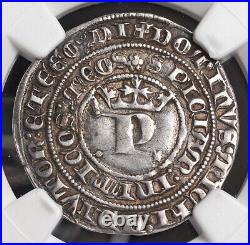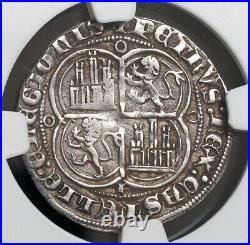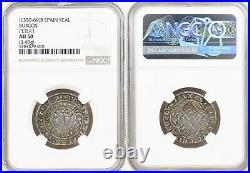1350, Spain, Peter I of Castil. Scarce Silver Real Coin. Burgos mint! NGC AU-50




1350, Spain, Peter I of Castil. Certified and graded by NGC as AU-50! Diameter: 26mm Weight: 3.49gm Material: Silver. Obverse: Crowned cypher of the King "P" within inner circle.
Pellets to end of left arm olf letter, star to right. All within double band of legends. Legend: + DOMINVS : MICHI : ADIVTOR : ET EGO : DI / SPICIAM : INIMCOS : MEOS Reverse: Arms of Castile and Leon in double tressure of four arches, annulets in spandrels, except in bottom where the mint letter (B) is located. Legend: + PETRVS : REX : CASTELLE : ELEGIONIS. Peter's rival Henry of Trastámara continuously depicted Peter as "King of the Jews", and had some success in taking advantage of popular Castilian resentment towards the Jews.
Henry of Trastámara instigated pogroms beginning a period of anti-Jewish riots and forced conversions in Castile that lasted approximately from 1370 to 1390. Peter took forceful measures against this, including the execution of at least five anti-Jewish leaders of a riot.
The prominence of Samuel ha-Levi, King Peter's treasurer, has often been cited as evidence of Peter's supposed pro-Jewish sentiment, but Ha-Levi's success did not necessarily reflect the general experience of the Spanish Jewry in this period which was often marked by discrimination and pogroms. Following Peter's death, Jews had to wear a yellow badge, as punishment for having supported him. 30 August 1334 - 23 March 1369, called the Cruel. , was King of Castile and León from 1350 to 1369. Peter was the last ruler of the main branch of the House of Ivrea.He was excommunicated by Pope Urban V for his persecutions and cruelties committed against the clergy. Popular memory generally views Peter as a vicious monster.
Much but not all of Peter's reputation comes from the works of the chronicler Pero López de Ayala, who after his father's change of allegiance had little choice but to serve Peter's usurper. After time passed, there was a reaction in Peter's favour and an alternative name was found for him. It became a fashion to speak of him as. The executor of justice (the Lawful).
Apologists were found to say that he had killed only men who would not submit themselves to the law or respect the rights of others. Peter did have his supporters. Even Ayala confessed that the king's fall was regretted by many, among them the peasants and burghers subjected to the nobles by late feudal gifts and by the merchants, who enjoyed security under his rule. The English, who backed Peter, also remembered the king positively. Geoffrey Chaucer visited Castile during Peter's reign and lamented the monarch's death in. Chaucer's patron, John of Gaunt, 1st Duke of Lancaster, had fought on Peter's side in his struggle to reclaim the throne.The English Lake Poet Robert Southey was presented in 1818 with a copy of a five-act play by the novelist Ann Doherty, entitled. Peter the Cruel, King of Castile and Leon. Peter had many qualities of those later monarchs educated in the centralization style. He built a strong Royal administrative force ahead of his times. He failed to counter or check all the feudal powers that supported his rivals, however illegitimate and opposite to the principles of aristocracy they represented themselves.
But his moral superiority was reduced too by the violent means, including fratricides, by which he sought to suppress opposition; he at times was extremely despotic and unpredictable, even by the standards of his age. In this he was preceded by his father Alfonso XI, who since the crisis at the death of Alfonso X had faced multiple rebellions against royal authority. The death of King Peter ended the traditional alliance of Castile and Navarre with England, which had been started by the Plantagenets to keep France in check. The alliance was later renewed by the Trastámaras and Tudors. This item is in the category "Coins & Paper Money\Coins: World\Europe\Spain".
The seller is "coinworldtv" and is located in this country: AT. This item can be shipped worldwide.
- Composition: Silver
- Country/Region of Manufacture: Spain
- Certification: NGC
- Denomination: Real
- KM Number: See detailed description section for full data!
- Grade: AU 50
- Year: 1530-1569
